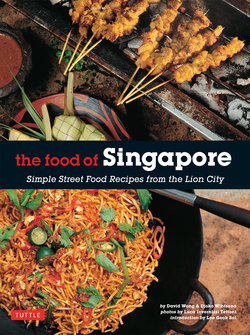Читать книгу Food of Singapore - David Wong - Страница 10
На сайте Литреса книга снята с продажи.
ОглавлениеThe Kopitiam Tradition
"Coffee shop talk" is a phrase Singaporeans use to describe gossip, and no wonder since the neighbourhood coffee shop or kopitiam is where news, views and grouses are exchanged over a cup of coffee or a quick meal.
In a typical kopitiam, a drinks stall at the back is run by the owner, who also sells breakfast items and small snacks. A typical breakfast at a kopitiam might include two slices of locally made bread lightly toasted over a charcoal grill, and served with a thick slice of chilled, melting butter, slathered with kaya (coconut and egg jam) or sprinkled with sugar. Soft-boiled eggs, eaten with soy sauce and pepper, are another kopitiam staple. The other kinds of food come from stall holders, who lease space from the owner These stall holders are usually of various ethnicities, adding to the customer's variety of choice cuisine. This is in fact where the concept for the food court originated—lots of food stalls with independent owner-cooks sharing the same dining venue. More often than not, there will be a stall selling Malay Nasi Lemak (fragrant rice cooked in coconut milk wrapped in banana leaves), roti prata and "economical noodles" (Hokkien mee or rice vermicelli stir-fried in sweet soy sauce, served with side dishes)—so named for its extremely reasonable price.
This watercolor by Daniel Wegera captures the tranquil mood of the old-style Singapore coffee shop—as much a social centre as a place to eat and drink.
Breakfast is washed down with kopi-o (sweet black coffee) or kopi susu (coffee with a few dollops of sweetened condensed milk), the usual morning beverages of heartland Singapore. Other variations of the morning brew include kopi-C, which is basically coffee with evaporated milk (the 'C' is for Carnation, a brand of evaporated milk). Replace kopi with the word teh, and you get tea. Add the word kosong—which means "empty" in Malay—and you get your cuppa sans sugar.
In a decent kopitiam of old, the owner roasted and ground his own beans, and some developed quite a reputation for their brew—as did their Malay counterparts in sarabat (ginger tea) stalls with their teh tarik. Singapore coffee is thick and strong; roasted corn and margarine are often added, along with a dollop of syrupy thick sweetened condensed milk. The local brew had a reputation of being illegal—stories circulated of how opium, once legal and easily available, was added to boost the potency of caffeine. Now most kopitiam owners depend on coffee factories for their supplies.
In the mornings, the kopitiam fills up quickly with people having breakfast before heading to the office or school. In the late morning, the crowd thins out but there are always a few shift workers or senior citizens who linger over a cuppa for some "coffee shop talk".
Towards lunch time, children attending the afternoon session drift in for an early lunch before school, followed by those who have just finished the morning session. Part of the lunch crowd is made up of workers from nearby shops and offices. Afternoons are a little quiet until evening brings back people in search of dinner, then the diners give way to those who gather to socialize over a pint of beer or stout.
The ebb and flow of customers depends much on the kopitiam's location and character. Some pack up by early evening, while others only do so in the wee hours of the morning. The kopitiam, in spite of rising competition from upmarket air-conditioned food centres and restaurants, firmly remains the heart and soul of Singapore.
These flask-like kettles, ideal for making coffee, are part of the typical kopitiam kitchenware Coffee powder is scooped onto a muslin sieve placed over the opening, and hot boiling water is poured over the powder The resulting brew is a smoky, fragrant concoction thai provides a powerful caffeine jolt.
